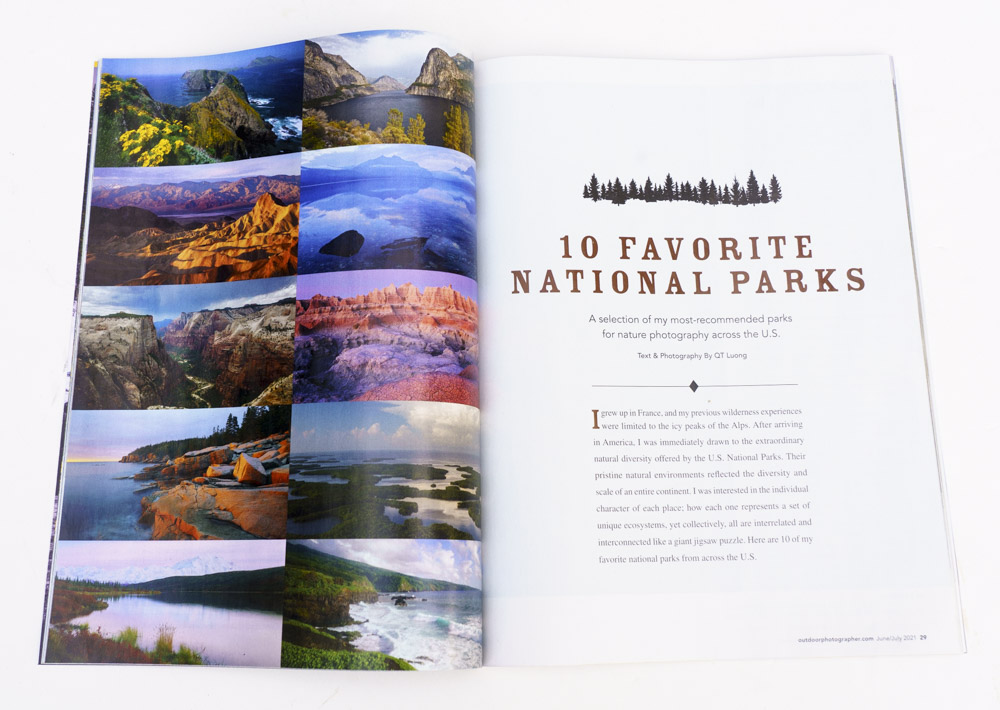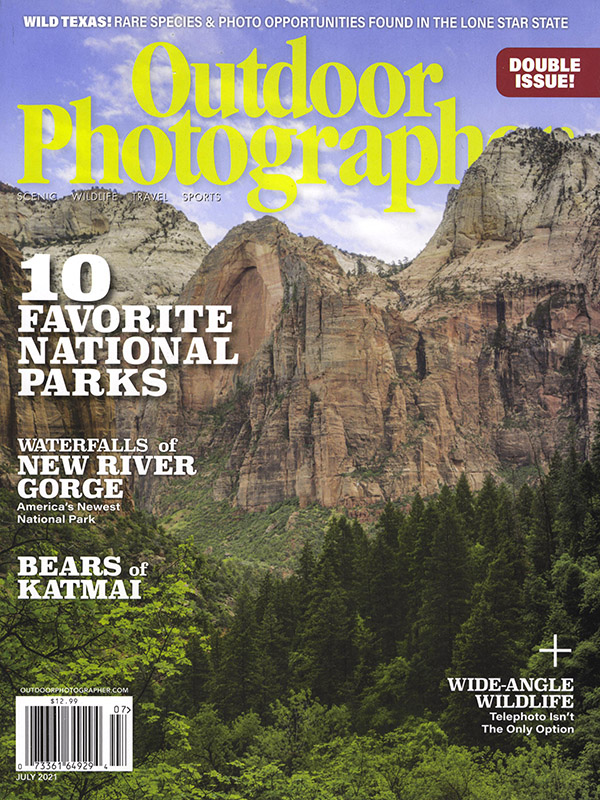New Outdoor Photographer cover article
No Comments
I am honored that for the second consecutive year, the summer issue of Outdoor Photographer includes my photographs in its opening article and on the cover.

The June/July 2021 issue was themed around the national parks, and I was lucky to receive my subscriber’s copy just a few days before I left for the New River Gorge National Park and Preserve, as it also featured an excellent article by local photographer Randall Sanger about the waterfalls of the New River Gorge. The format of my article was similar to last year’s: a selection of 10 national parks. Last year’s idea was to pick 10 parks that were not amongst the most famous, yet had a unique feature – don’t they all anyways? The title for this year’s article is “10 Favorite National Parks” with the reading line “A selection of my most-recommended parks for nature photography from across the U.S.” Both were provided by the editor, but the article is actually not a “top 10” list. If anything, the fact that I avoided repeating any of the national parks in last year’s article by itself may have been enough to skew the list.
Based on their merits alone, it would be difficult to draw a top 10 list, just because they are so different, which is why I have refrained from the popular exercise of ranking the parks from “best” to “worse”. However, the list does include my favorite national park. Based on the park merits alone, that would be even a more difficult pick than a “top 10” list, but based on my relationships with the parks, it is an easy choice. Yosemite is my sentimental favorite because it was the first National Park I had heard of and visited, the park that drew me to California, and because of all the time, I have spent there on repeated visits, not only photographing, but also hiking, climbing, and skiing.
The idea behind this year’s list is best captured by the words “from across the U.S.” What fascinated me so much about the national parks and compelled me to try to visit all of them was the diversity of nature found within the system. Each park represents the highest type of its particular environment, yet collectively they are all are interrelated. As this country encompasses an entire continent, its national parks represent such diversity of eco-regions and climatic extremes. There are several other ways to organize a book about the national parks: by alphabetical order, date of first designation, date of establishment as a national park, geographic type, states, or even visual flow. But the organization by region has always sounded the most natural, and I thought carefully about the division in Treasured Lands. The article used a similar organization, except that without the need for balance, 10 is a more round number than 7. Some regions chosen in Treasured Lands (for instance “Pacific Coast and Mountains” or “Rockies and Prairie”) split naturally. Therefore, for the article, I picked one park each in those ecoregions: Pacific Coast, Sierra Nevada, Colorado Plateau, Desert, Rocky Mountains, Prairie, East Coast, Gulf Coast, Alaska, and the Tropics. The criterion was that each of them would offer some of the most numerous and diverse subjects to photograph among its peers. The entire article is available here.

I commented before on the particular constraints of cover images, and this year’s choice is another case in point. More striking and unique images were considered, but the editor thought that they didn’t communicate “National Parks” for the newsstand buyer. They felt that the one chosen, besides meeting other design criteria, did communicate that. I was asked if I had a variation with more sky, but since I didn’t, the designer found a way to make it work. It was a bit of a challenge to tell a behind-the-scenes story for that image, but I was greatly helped by being able to easily pull out the entire output of that afternoon in Lightroom – better than a contact sheet. As simple as it may look, as long as any image is made deliberately, there is a story behind it.
Zion National Park is famous for its sheer cliffs and narrow canyons, but it is also a remarkable oasis in the desert. One of my favorite places to photograph water and lush vegetation is the popular Emerald Pools Trail, where waterfalls flow over walls and alcoves. Lower Pool is a flat, 0.5-mile one-way hike from Zion lodge; each of Middle and Upper Pools adds another 0.25 miles and a 200-foot elevation gain. In previous autumn visits, I had found colorful foliage, as red maples are abundant. However, the waterfalls were a trickle. I was hoping for spring runoff in mid-May. Although better than in the autumn, the waterfalls turned out not to be raging – one would need to come during a storm.
Hiking back from Upper Pool, I noticed a composition made possible by the higher viewpoint, with green new leaves contrasting strikingly with darker conifers and red cliffs. Although straightforward looking, it needed particular light conditions to work. The area is front-lit in the morning and shaded in the late afternoon. With the sun in the back, the rock walls on the canyon’s other side were too bright when sunlit. Thanks to fast-moving clouds, I didn’t have to wait too long for thin clouds to soften the light, reducing the contrast to a manageable level. I hurried to photograph while there was an opening of blue sky above the cliffs. A few minutes later, it was gone, replaced with a less appealing overcast sky.

